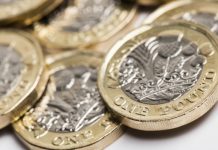The Australian Dollar is dipping lower versus the Pound, snapping a 6-session winning streak. The Pound Aussie Dollar exchange rate settled on Monday -0.6% lower at 1.8694 amid a broad risk on rally.
At 09:15 UTC, GBP/AUD is trading +0.1% higher at 1.8698. The is mid-way between the daily traded range of 1.8656 – 1.8740 as investors digest a tick lower in UK unemployment rate and the minutes from the latest Reserve Bank of Australia’s monetary policy meeting.
Record Jump in UK Jobless Claims
The Pound advanced following the release of UK labour market data. UK jobless claims, a measure of the number of people claiming unemployment benefit in the UK jumped by the largest amount on record in April; the first full month of coronavirus lockdown.
The claimant count increased by 856,500 in April a 69% jump from the previous month and significantly higher than the 150,000 expected by analysts. The increase would have been even larger had it not been for the government’s job retention scheme, which pays 80% of workers wages who are put on temporary leave by their employers.
The UK unemployment rate unexpectedly fell in the three months to March, to 3.9%, down from 4%. This data only includes the first week of lockdown which explains why its so low. Going forward the Bank of England predicted that unemployment could reach 10% in the coming quarter.
Australian Economy To Contract -10%
The Australian Dollar was trading on the back foot on Tuesday after an impressive rally across the previous week.
The minutes from the latest RBA meeting on 5th May were weighing on the Aussie. The RBA left rates unchanged at 0.25% at the meeting and recommitted to buying as much government debt as necessary.
The central bank warned that Australia is facing an unprecedented economic downturn as a result of the pandemic. However, policy makers also thought that the huge monetary and fiscal stimulus efforts would help soften the blow to the economy.
As a base case scenario, policy makers are expecting GDP to fall by -10% in the first half of this year and 6% across the year as a whole. Australia has not experienced a technical recession of two consecutive quarters of contraction since the early 1990’s.





